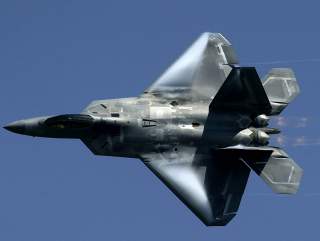The Forgotten Reason an F-22 or F-35 Is Superior to China's J-20 Stealth Fighter
“It’s about a network and that’s what gives us an asymmetrical advantage, so that why when I hear about an F-35 versus a J-20, it’s almost an irrelevant question.”
One area that the Chinese are almost certainly lacking is what Air Combat Command commander Gen. Herbert “Hawk” Carlisle once described to me as “spike management.” Fifth-generation aircraft such as the F-22 and F-35 have cockpit displays that indicate to the pilot the various angles and ranges from which their aircraft can be detected and tracked by various enemy radars.
“When we apply fifth-generation technology, it’s no longer about a platform, it’s about a family of systems,” Air Force chief of staff Gen. David Goldfein told reporters at the Pentagon on Aug. 10. “It’s about a network and that’s what gives us an asymmetrical advantage, so that why when I hear about an F-35 versus a J-20, it’s almost an irrelevant question.”
(This first appeared last year.)
Indeed, as Goldfein noted, the Air Force will likely to continue its focus on a family of systems approach where networking and the sharing of data are key instead of fixating on the performance of individual platforms. A direct comparison of the Lockheed Martin F-35 and the J-20—in Goldfein’s view—would harken back to the his days of flying the Lockheed Martin F-117A Nighthawk stealth fighter—which was almost entirely cut off from outside contact when buttoned down to penetrate enemy airspace. “You’ll see us focusing far more on the family of systems and how we connect them together and far less on individual platforms,” Goldfein said.
While Goldfein used the Nighthawk as a comparison—he probably did not intend to suggest that the J-20’s systems are quite as basic as the 1980s-era F-117. While accurate information about the J-20 is scarce, there are indications that the Chinese aircraft is equipped with a phased array radar, a robust electronic warfare systems and an electro-optical/infrared sensor that is similar in concept to the F-35’s systems. However, while it is possible that the Chinese aircraft might have decent sensors—Air Force officials have suggested that the J-20 lacks the “sensor fusion” and networking to be as effective as the F-22 or F-35.
One area that the Chinese are almost certainly lacking is what Air Combat Command commander Gen. Herbert “Hawk” Carlisle once described to me as “spike management.” Fifth-generation aircraft such as the F-22 and F-35 have cockpit displays that indicate to the pilot the various angles and ranges from which their aircraft can be detected and tracked by various enemy radars. The pilots use that information to evade the enemy by making sure to avoid zones where they could be detected and engaged. It is a technology that took decades for the United States to master—through a lot of trial and error.
Recommended: What Will the Sixth-Generation Jet Fighter Look Like?
Recommended: Imagine a U.S. Air Force That Never Built the B-52 Bomber
Recommended: Russia's Next Big Military Sale - To Mexico?
Meanwhile, at the same press conference, Air Force secretary Deborah Lee James decried the possibility of facing another year where the Congress fails to pass a budget. Even if Congress passes a full year continuing resolution (CR)—which maintains the previous year’s spending levels—it would massively disrupt the Air Force’s procurement efforts because the service would not be able to award new start program contracts. “We certainly hope that won’t be the case, we know the Congressional staffs are working very hard even while their members are back home this summer, but we are hearing that either a six-month CR or one-year CR is at least a possibility,” James said.
Indeed, Congressional sources are not optimistic about the prospects for a new budget in the fall. Thus, the Pentagon faces additional budget turbulence even as it grapples with a readiness crisis.
Dave Majumdar is the former defense editor for The National Interest.


